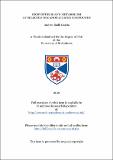Files in this item
Biosynthesis and metabolism of selected organofluorine compounds
Item metadata
| dc.contributor.advisor | O'Hagan, David | |
| dc.contributor.author | Rodil García, Andrea | |
| dc.coverage.spatial | xi, 288, [11] p. | en_US |
| dc.date.accessioned | 2019-09-17T10:40:00Z | |
| dc.date.available | 2019-09-17T10:40:00Z | |
| dc.date.issued | 2019-12-03 | |
| dc.identifier.uri | https://hdl.handle.net/10023/18485 | |
| dc.description.abstract | The St Andrews group has recently developed a range of novel fluorinated motifs, which include all-cis fluorocyclohexanes, difluoro oxy- and thio- ethers and α,β,β-trifluorocyclopropanes. Fluorinated motifs are often sought after in medicinal chemistry, and it became one of the aims of this thesis to explore these new motifs in order to assess their validity for drug discovery programmes. The metabolic stability of each motif was probed in incubations with Cunninghamella elegans. This fungus is well known for its ability to biotransform xenobiotics mimicking the mammalian P₄₅₀ profile, and thus, providing a useful model for metabolic vulnerability. This showed that the all-cis cyclohexyl derivatives were increasingly stable to the action of P₄₅₀’s with increasing fluorine substitution. The α,α-difluoro thioethers showed oxidation to sulfoxides and sulfones, and the difluorooxy analogue showed a rapid biodegradation into the corresponding acetate ester. The studied α,β,β-trifluorocyclopropanes proved challenging to isolate and identify, but it could be established that the fluorinated motif remained intact after the incubations. The enantioselectivity with which C. elegans transforms the products was explored by chiral HPLC, which allowed an estimation of the enantiomeric resolution of racemates, and also the enantioselectivity of sulfoxide formation. In both cases selectivities were relatively low. Additionally, the lipophilicity of the fluorinated motifs was calculated by reverse-phase HPLC. A general trend was that increasing fluorination led to increased polarity. A second aim was to explore the fluorometabolite biosynthesis in Streptomyces sp. MA37, isolated in Ghana (2014), which contains an active fluorinase. The metabolic pathway in Streptomyces sp. MA37 branches at 5-fluororibose phosphate (5-FDRP), allowing the formation of 5-fluoro-2,3,4-trihydroxypentanoic acid (5-FHPA) and other unknown metabolites. Each of the steps leading to 5-FHPA was studied, and the biotransformation was reconstituted in vitro. The production of fluorometabolites by Streptomyces sp. MA37 was investigated by carrying out cell-free and whole cell feeding experiments with [5’,5’-²H₂]-5’-FDA. Incorporation into the fluorometabolites from [5’,5’-²H₂]-5’-FDA was successful. | en_US |
| dc.description.sponsorship | "This project was funded – and therefore possible – by the Marie Curie 7th Framework, and the European Union, as part of the Fluor21 Network." -- Acknowledgements | en |
| dc.language.iso | en | en_US |
| dc.publisher | University of St Andrews | |
| dc.relation | A. Rodil, S. Bosisio, M. S. Ayoup, L. Quinn, D. B. Cordes, A. M. Z. Slawin, C. D. Murphy, J. Michel, D. O’Hagan; Chem. Sci. 2018, 9, 3023. http://hdl.handle.net/10023/12800 | |
| dc.relation | R. Tomita, N. Al-Maharik, A. Rodil, M. Bühl, D. O’Hagan; Org. Biomol. Chem. 2018, 16, 1113. http://hdl.handle.net/10023/16826 | |
| dc.relation.uri | http://hdl.handle.net/10023/12800 | |
| dc.relation.uri | http://hdl.handle.net/10023/16826 | |
| dc.subject | Fluorine metabolism | en_US |
| dc.subject | Fluorinase | en_US |
| dc.subject | Cunninghamella elegans | en_US |
| dc.subject | Streptomyces sp. MA37 | en_US |
| dc.subject.lcc | QD412.F1R7 | |
| dc.subject.lcsh | Organofluorine compounds--Synthesis | en |
| dc.subject.lcsh | Organofluorine compounds--Metabolism | en |
| dc.subject.lcsh | Biosynthesis | en |
| dc.subject.lcsh | Streptomyces | en |
| dc.title | Biosynthesis and metabolism of selected organofluorine compounds | en_US |
| dc.type | Thesis | en_US |
| dc.contributor.sponsor | Seventh Framework Programme (European Commission) | en_US |
| dc.contributor.sponsor | Marie Curie Initial Training Network FLUORINE21 | en_US |
| dc.type.qualificationlevel | Doctoral | en_US |
| dc.type.qualificationname | PhD Doctor of Philosophy | en_US |
| dc.publisher.institution | The University of St Andrews | en_US |
| dc.identifier.doi | https://doi.org/10.17630/10023-18485 |
This item appears in the following Collection(s)
Items in the St Andrews Research Repository are protected by copyright, with all rights reserved, unless otherwise indicated.

